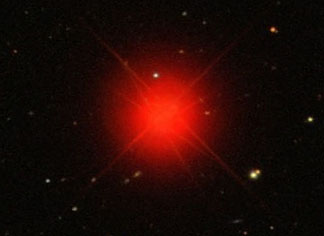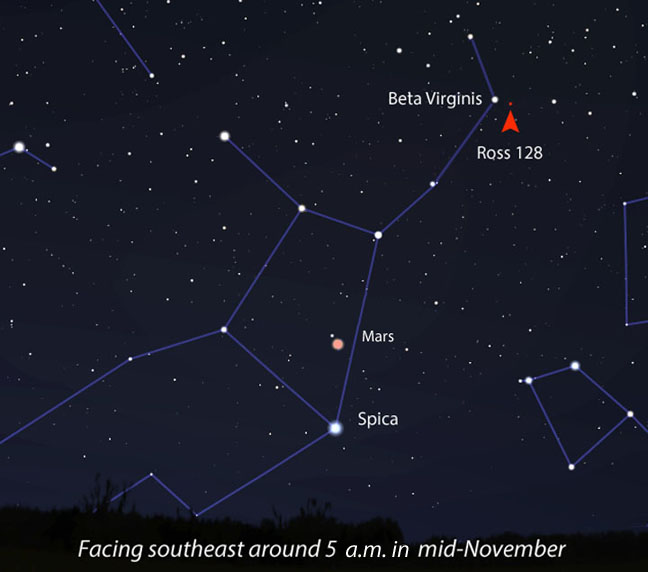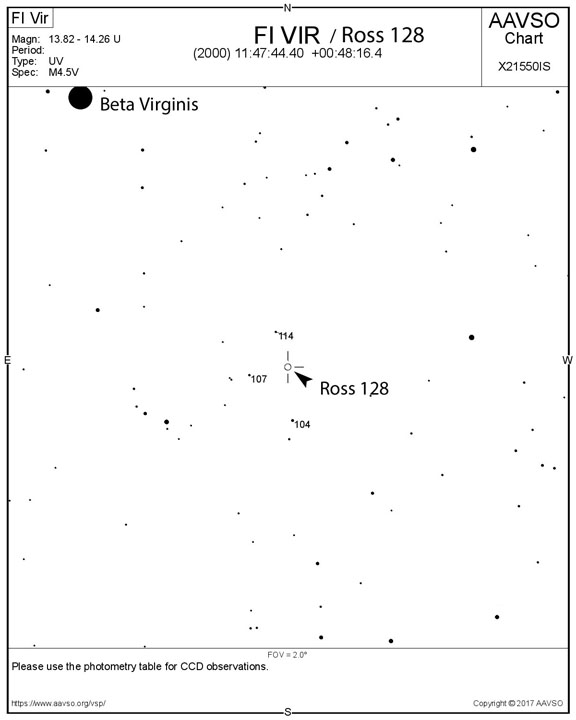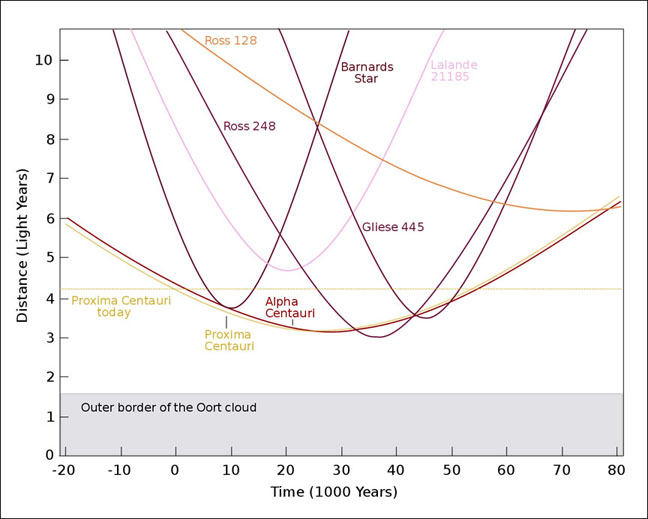With exoplanet Ross 128b in the news, we pay a visit to the star that sustains this potentially habitable exoplanet.

Sloan Digital Sky Survey
No matter where you look the fecundity of the universe is manifest. Consider exoplanets. Since the first was discovered in 1992, astronomers have been piling them on like mashed potatoes at Thanksgiving. Today we know of more than 3,700. Of those, 53 may be potentially habitable.
The most recently discovered potentially life-friendly planet — and in some ways the most exciting — is Ross 128b, which circles the red dwarf star Ross 128 in the constellation Virgo. Located just 11 light-years away, it's the second closest Earth-sized planet within the habitable zone of its star.
Astronomers estimate that temperatures on Ross 128b range from –76° to 68° F (–60° to 20° C). You could argue that's even more temperate than than that of Earth and likely warm enough for liquid water to pool on its surface. What's more, its star experiences far fewer massive flares compared to other red dwarfs, making conditions more hospitable to potential life.

Stellarium
While you and I aren't going to see Ross 128b anytime soon, we can have the pleasure of seeing its host sun, Ross 128. Currently visible in a dark sky before the start of dawn, this newsy red dwarf is just 1.1° southwest of 3rd-magnitude Beta (β) Virginis. To find the dwarf and its mind's-eye planet, center Beta in the field of view and use the AAVSO map to star-hop right to it.

AAVSO with annotations by the author
Eager to see it for myself, I got up the first clear morning after the news of the discovery broke last week. Oh gosh, how easy could it be. Pale red and magnitude 11.2, Ross 128 is bright enough to spot in telescopes as small as 4 inches (10 cm). Mingled in the star's light were photons from its closely orbiting and perhaps habitable planet, a satisfying thought.
Some 80% of the Milky Way's stars are red dwarfs, yet not a single one is visible to the naked eye. Being something of an introvert, I cotton to these shy suns. The brightest, Lacaille 8760 in Microscopium, shines at magnitude 6.7. Despite their retiring nature, they make for fertile exoplanet hunting grounds. A tiny dwarf feels a much stronger — and more easily measurable — tug by an orbiting planet compared to a bigger star like our Sun.

FrancescoA / CC SA-3.0
If we're patient and smart enough not to destroy ourselves, we'll have an even better view of Ross 128 in due time. The star is moving towards us at 31 km/sec and will become our nearest stellar neighbor around 81,000 AD, when only 6.2 light-years will separate the two Earths.
We celebrate Thanksgiving this week, a time to be grateful for all we have. As we reflect on the ups and downs that sustain our lives, feel free to take another helping at the table, including this stellar cranberry.
 12
12









Comments
Tom-Reiland
November 22, 2017 at 5:33 pm
I remember taking photographic plates of Ross 128 many years ago at Allegheny Observatory. Later, we used the MAP (Multi-channel Astrometric Photometer) to measure its distance, proper motion and to try to detect a wobble that might indicate Jupiter-sized planets. No luck finding anything that large.
You must be logged in to post a comment.
Bob KingPost Author
November 23, 2017 at 11:01 am
Thanks for sharing that, Tom. Now, if there had been a hot Jupiter there, you may have gotten a signal.
You must be logged in to post a comment.
Tom-Reiland
November 24, 2017 at 3:32 pm
Bob, I was able to observe Ross 128 this morning when I was at Wagman Observatory. It was easy to find using the AAVSO chart. I estimated it at 11.6 mag. I also spotted the Nova in Orion, which is down to 12.5 mag, give or take 0.1 magnitude. It was a decent late Fall night for Star-hopping. I had to wait for the clouds to finally clear out and didn't get started until 2 AM. I quit by 5:30.
You must be logged in to post a comment.
Bob KingPost Author
November 24, 2017 at 5:56 pm
Tom,
Easy it is! Can you tell me though - do you mean the nova in Oph or is there one in Orion?
You must be logged in to post a comment.
Tom-Reiland
November 24, 2017 at 11:57 pm
There is a Nova in Orion that was discovered on 11/21. It's on the CBAT page. I think it's the 4th one that I've observed this year to go along with 10 SNs. The AAVSO has been posting magnitude estimates.
You must be logged in to post a comment.
Bob KingPost Author
November 25, 2017 at 9:18 am
Hi Tom,
Do you have a link to the nova discovery? I'm having no success. I see CBAT circulars through Nov. 20th only. Thanks 🙂
You must be logged in to post a comment.
Tom-Reiland
November 25, 2017 at 4:06 pm
Bob, Here's the page: http://tamkin1.eps.harvard.edu/unconf/tocp.html for Objects to be confirmed. Here's the designation: PNV J05580574-00111555. I used this number on the AAVSO page to get the chart and magnitude estimates.
You must be logged in to post a comment.
Bob KingPost Author
November 25, 2017 at 9:33 pm
Thanks, Tom. I learned via the AAVSO today that this transient has been classified as a cataclysmic variable (UGSU dwarf nova) rather than a nova. Darn! Still, dwarf novae are pretty cool, too 🙂
You must be logged in to post a comment.
Tom-Reiland
November 27, 2017 at 1:53 pm
Thanks for the info about the dwarf nova/variable in Orion, Bob. I finally got a chance to observe Comet Tsuchinshan in Leo. It wasn't easy. Not sure of the magnitude. Probably 11 magnitude or a little fainter. I observed it's motion, slight as it was, over a period of an hour. Mostly averted vision. I'm getting tired of these faint, little fuzzy blobs. We need a Comet West or Hale-Bopp type of comet.
You must be logged in to post a comment.
Bob KingPost Author
November 27, 2017 at 8:15 pm
Tom,
I'm with you on the comets. I recently had the opportunity to view 62P, C/2017 O1, C/2016 R2 (in Orion by the way) and 24P/Schaumasse. All of them were dim balls of fuzz around 10-11 mag. Such is the ebb and flow in the life of a comet watcher.
You must be logged in to post a comment.
Joe Stieber
November 25, 2017 at 5:00 pm
With really clear weather this morning (Saturday, 25-November-2017), I went out to the New Jersey Pines for a look under relatively dark skies. Although a bit dim, I was able to see Ross 128 unambiguously with my 85 mm (3.4 inch) spotting scope at 60x. I did not notice any red color -- I suspect I might need a bit more aperture for that. It was also clearly visible on a snapshot I took with my DSLR and a telephoto lens on a fixed tripod. The picture is currently at the top of my web page, http://sjastro.org/ .
You must be logged in to post a comment.
Bob KingPost Author
November 25, 2017 at 9:35 pm
Nice, Joe! Way to take it to the limit. I hope others with small scopes are so inspired.
You must be logged in to post a comment.
You must be logged in to post a comment.